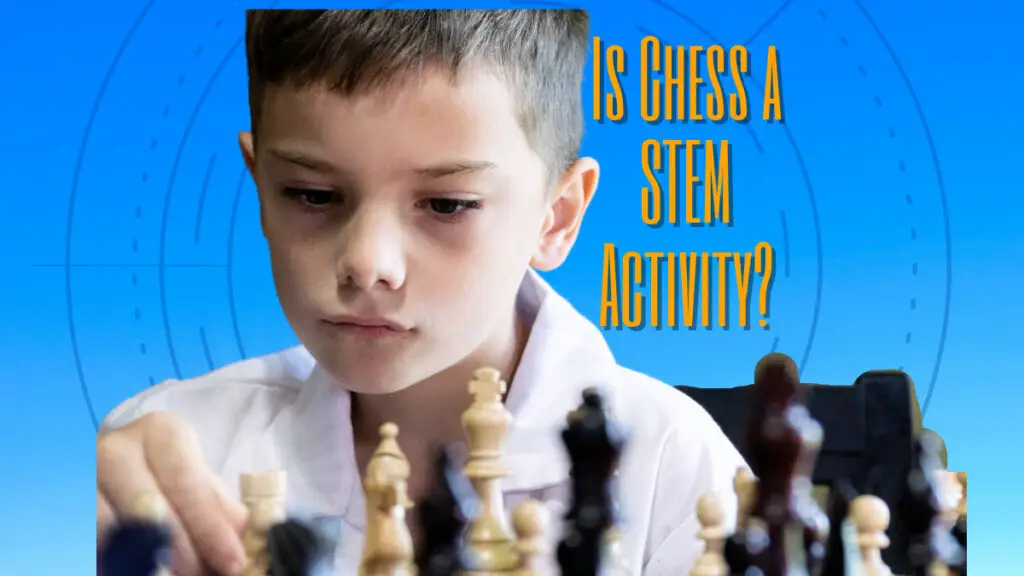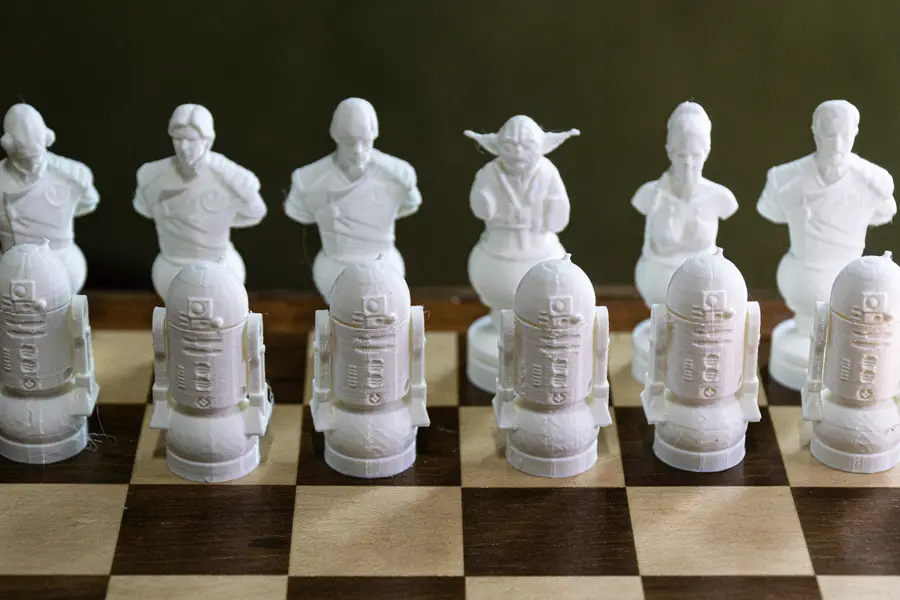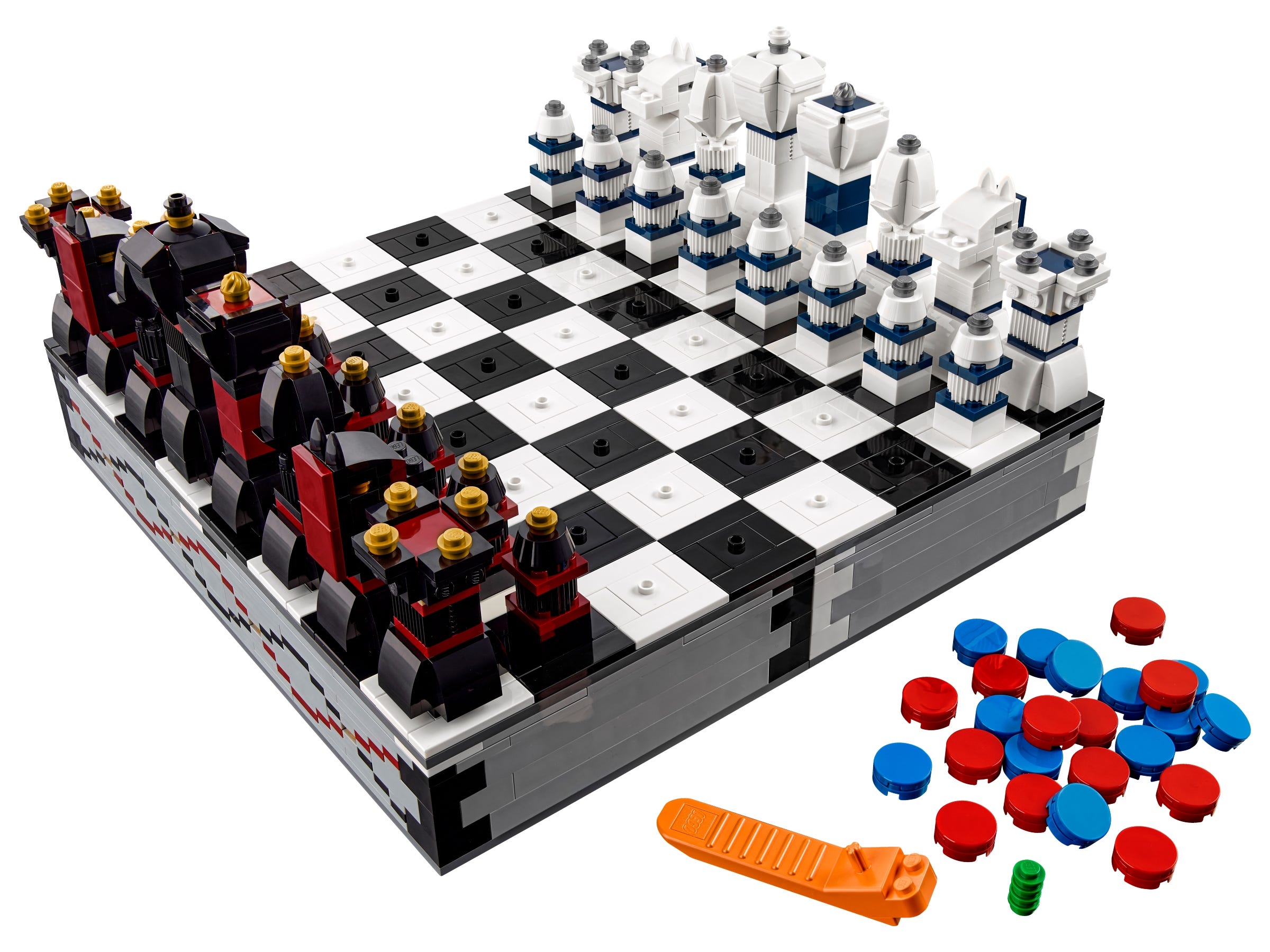Chess most recently became trendy (again) after Netflix turned Walter Tevis’ 1983 novel The Queen’s Gambit into a series. No doubt about it, good chess players are intelligent. But many parents want to know: is chess a STEM activity?
Chess is a STEM activity. At its foundation, the game is based on mathematics. Playing chess cultivates skills needed in any STEM career: patience, problem-solving, creativity, abstract reasoning, improved memory, concentration, critical thinking, strategic planning, and visualization skills.

*We’re an affiliate – we may earn a commission through qualifying purchases from the links on this page. As always, thanks!*
Chess is an accessible game that is enjoyed from preschool age well into retirement. It is a game that has brought people together worldwide, builds confidence, and exercises the brain. The game is inexpensive to play (just need a board and pieces) and bridges the generation gap. This makes chess an excellent STEM tool, including in lower-income areas.
Let’s explore how chess is a STEM activity.
What STEM Category Does Chess Fall Under?
Chess is rooted in mathematics. It is a game of patterns, probability, and calculation. Each piece has a number, and each square on the board does too. Thus, STEM programs that are trying to boost math and programming skills in students often use chess. This is partly why Devin Nakano created the nonprofit Y STEM and Chess.
In 2015 Giovanni Sala, Alessandra Gorini, and Gabriella Pravettoni released a paper titled “Mathematical Problem-Solving Abilities and Chess: An Experimental Study on Young Pupils.” The paper looked into if chess enhanced children’s mathematical abilities (spoiler alert: yes, it does).
John C White wrote an entire paper on A Mathematical Analysis of the Game of Chess. The 2018 paper is some heavy reading, so we’ll give you the one line summary: The paper concludes that while math can enhance a person’s chess game, it will not perfect it. Which, due to the complex nature of the game, makes sense.
Easier to sift through is The Washington Post article “The Mathematically Proven Winning Strategy for 14 of the Most Popular Games.” The article discusses which squares are most utilized by chess masters and the most popular moves in history. It also rates each pieces’ chances of survival, proving it’s not always a death sentence to be a pawn.
How Chess Relates to Mathematics
The National Academy of Sciences states, “Mathematics is a science of pattern and order.” Chess echoes many of the qualities that are the nature of mathematics:
- Patterns
- Logic
- Statistics
- Probability
- Spatial reasoning
- Predictive reasoning
- Geometric concepts
- Based on a coordinate system
Chess pieces sit on a board according to coordinates. The pieces move in geometric patterns such as vertically, horizontally, diagonally, or, in the case of the knight, a patterned movement of 2:1 combination of vertical and horizontal movements.
The game of chess demands players think logically and predict moves based on the probability of the options the board presents. However, because it is believed that there are 1043 possible legal positions in chess, the human brain can’t make all the calculations as some people can do with games like Black Jack.
Which doesn’t mean a person only plays using solid mathematical skills. Because, like any sport, it is also a strategic game, and moves might be made to mess with an opponent’s head. Emanuel Lasker was known for purposely making poor appearing moves to unsettle the other player.
Why Chess Players Study Openings
Despite chess being rooted in mathematics, the human brain is not a computer and thus is limited to what it can calculate. This is why chess players study moves and the patterns and probability those moves lead to the next move.
Thus, the first move of the game, known as the opening, is crucial. How a player opens helps protect them from traps and makes it easier to predict future moves and patterns both from themselves and their opponent.
Some popular openings are:
- English Opening
- French Defense
- Italian Game
- Pirc Defense
- Reti Opening
- Ruy Lopez
- Sicilian Defense
Chess Endgames
Endgames is a more challenging study as there are so many possibilities, unlike the start of the game where every piece begins on the board in a set place. Thus, the study of endgames is more of a series of logical puzzles to practice than a set of standard moves.
That said, there are some standard principles, strategies, and “rules” when playing an endgame. Some of the basics can be found here, and another good one is here. It’s about understanding the patterns of movement of pieces and how they relate to the other pieces, and their board position.
Chess enthusiasts love making endgame puzzles. One of the most famous and infuriating examples is Plaskett’s Puzzle thought up by Gijs van Breukelen from around 1970.
Historical Mathematical Chess Puzzles
Chess is mathematics, but sometimes mathematics is chess. Classical mathematical puzzles we would now refer to as “brain teasers” have been presented using the chessboard. Here are two famous examples.
A Knight’s Tour
A Knight’s Tour is a riddle, if you will, that appeared around in an Arabic manuscript over a thousand years ago. The aim is to create an order of moves for a single knight that will allow it to hit every square on the chessboard without repeating a square.
If you are interested in a backtracking computer analysis of A Knight’s Tour, you can read more here.
The Eight Queens Puzzle
The Eight Queens Puzzle is a brain teaser presented by Max Bazzel, a chess player in 1848. As the name of the puzzle suggests, eight queens are placed on a chessboard. The catch? You need to place all eight, so they are not “threatening” to capture (take) the other. There are 92 solutions, with 12 being what is called “unique” or “linear independent” solutions.
If you change the board, say from 8 x 8 to 7 x 7, the solutions would drop to 40 with only 6 unique. You can find more info about the possibilities here.
Chess for STEM
While chess does have its roots in mathematics, the benefits of chess go well beyond just one part of the STEM acronym. Logic, spatial skills, and problem-solving are but a few of the many skills that chess develops. These are all necessary for any STEM career, and are valuable life skills.
Grandmaster Dr. Milan Vukcevich was quoted as saying, “chess forces one to develop one’s own methodology for solving problems that can be applied throughout life. Chess makes better thinkers and should be played, not with the idea of becoming a professional player, but that chess players become doctors of sciences, engineering, and economy.”
Does Chess Make You Smarter?
There is a difference between increasing intelligence and improving skills through training. While chess has many benefits, including improving memory skills, planning skills, and critical thinking skills, the research on if it actually makes you smarter is sparse. In fact, Giovanni Sala and Fernand Gobet argue that while the game is good training, it doesn’t make you smarter. The complete meta-analysis can be found here.
Not everyone agrees, however, including Dr. Robert Ferguson, Jr. In a Chess and Education Research Study, it was proposed that, “children who learn chess at an early age achieve more in the traditional maths and sciences.” and that “the most striking benefits are those associated with problem-solving and creativity.”
There is research suggesting chess helps to protect or prevent dementia. How much chess helps after dementia has been diagnosed is not known, however.
Some studies show that playing chess boosts reading scores, encourages creativity, and increases problem-solving skills. Other studies find evidence that chess improves empathy, helps with mild AD(H)D, and can be an excellent tool for managing panic attacks. In addition, chess has been shown to have a positive impact in inner-city schools and with students with special needs.
So, while there is no definite research that chess will make your child smarter, it will improve skills and can help manage mental health. In this way, chess can be compared to the benefits of sports for our physical health. Like any sport or activity, chess can be a place where a player has aptitude and can shine.
What Age Can a Child Begin Learning Chess?
Chess is a game that is suitable for any age. However, it is best not to push it and sour a child against playing. So while you can start a toddler on chess concepts, it is often not recommended to begin until four. Many educators feel waiting until the child is 7 or 8 unless the kid has expressed explicit interest, is best.
Our son developed an interest in chess at age 5. It was on the game shelf next to favorites like Candyland, and I was a bit skeptical when he got our chess board out and asked to play. He was enthusiastic and picked up on each piece’s movements quickly and still enjoys the game. We found a chess game that he can play on our Roku, and he often plays chess instead of watching a show on TV.
Chess can stop being fun, however, if there are pushy parents or when children reach higher levels of competitiveness. Environments of high-stress risk the benefits of chess being eroded due to poor mental health. It is key to remember that this is a game and should be fun.
Also, a successful career in STEM does not require a child to have been a Grandmaster, or even an accomplished chess player. If anything, dedication to become a Grandmaster would distract from pursuing a career in anything other than chess. Thus, it is important to keep chess as a fun activity and experience for kids, so they want to play the game, rather than feel it is a different type of homework.
Chess Sets for All Skill Levels
A great way to start chess with kids is No Stress Chess. This set focuses on the basic moves rather than overall strategy. On each turn, players choose from the included cards which show a piece and its movement. Making chess moves by drawing a card can make for some pretty odd games. The focus is to teach each piece’s movement and make it easy to play (hence the “no stress” moniker.) As players get more advanced, they can draw more cards and strategy starts to creep in. Before you know it, you’re playing chess!
For a solid all around chess set, this one is great: The wooden board folds into a case for travel and storage. The pieces are hand carved wood with felt on the bottom. The set also comes with checkers pieces, so it’s two games in one. It looks great and is reasonably priced.

This folding magnetic one will suit most needs and is great for beginners. The board is magnetic to hold the pieces in place and folds in half to form a case to travel or stash away. If your budding chess star is prone to bumping the board, the magnetic pieces can help. It’s priced right, and is easily giftable.
Chess sets come in all kinds of styles and themes, like Star Wars, Marvel Superheroes (the paint and detail on this set looks awesome), Super Mario, Roman Gladiators, Civil War, Politics, and well, you get the idea. We even found a cool magnetic set that hangs like a piece of wall art and is playable.

If you’re into Lego, this is awesome! Lego has a chess set you can build
You can even 3D print your own chess pieces if you’ve got access to a printer:

Free Printable Chess Set
No chess set? No Problem! Download our free printable chessboard and pieces. Cut out the chess pieces and you’re ready to play. Perfect for learning the game, and it doesn’t get any easier or more compact for travel than a piece of paper.
Chess Apps and Websites
Yes, people have managed to play chess for generations without fancy websites and apps. All anyone needs are two players and a chessboard. But parents get busy, kids get bored, and the internet is a great place to find a vast amount of information and other players. Besides, eventually, your child is going to beat you and want higher caliber opponents.
Thus, we’ve put together a list of 20 chess apps and websites. Lichess and Atomic Chess are our favorites. But you’ll find plenty of other great choices that suit various ages, skill levels, and personalities. Most importantly, many of these sites are fun, which will help keep your child interested in the game.
Atomic Chess
Atomic Chess is a game on Chess.com. It’s a favorite because, yes, pieces explode. Both girls and the boys find this highly amusing. But it also creates a unique strategy challenge because when a piece blows up it impacts the squares around it. Good times.
Chess.com has other fun variants, that are fun as well like 4 player chess, where there’s a set on each side of the board and a horde of pawns where one side has 5 rows of pawns while the opponent has a regular line up of pieces.
Chess4Life
Chess4Life is a website that teaches chess to children ages 5 to 16. The coaches follow a fun curriculum while providing the necessary skills to play the game with confidence, patience, and critical thinking. The site hosts group classes, chess clubs, and tournaments.
Chessable
Chessable is now owned by Chess24.com and is a platform that allows users to zero in on specific chess skills and concepts. There are courses aimed at Openings, Endgames, Strategy, and Tactics. This is great for kids and adults who’ve caught the chess fever and want drills to fine-tune their game.
The platform also hosts many famous chess players and their books. Magnus Carlsen has been brought on for Move Trainer, described as “a tool that can help players at different levels improve their chess games in an effective way.”
Chess Kid
ChessKid.com is a fun site that provides online chess, puzzle games, and lessons. Parents and kids love this popular site. Free membership offers unlimited chess games and up to three puzzles a day.
Gold Membership is a paid subscription that gives you access to the entire site. However, you can give Gold Membership a try for a month at no cost. The video tutorials are fun and engaging, teaching the kids essential concepts in order to play a skillful game.
Chess for Kids
Chess for Kids is a free app designed by Chess.com. This is an incredibly popular app that not only has chess but other puzzles. There is also a paid membership that gives unlimited access to their videos, lessons, and as many puzzles as your child desires. The app provides a mini-crash boot camp on how the pieces move and winning strategies.
Chess Matec
Chess Matec is a website aimed at children between the ages of 4 to 9. There are video tutorials, a chess app, and printable worksheets. There is even a section for educators and coaches. Chess Matec has also hosts Chess Matec Portal that parents find helpful when teaching their kids chess.
Chess Prime 3D
Chess Prime 3D is available for Android and IOS. As the game suggests, it comes with 3D graphics, although 2D options are available for those who prefer. Players can play against the AI or against each other and interact. The app helps show you where you can improve, and novice players will enjoy the option to show potential moves.
Chess Tiger
Chess Tiger is an app for IOS, Android, and Windows. This is a great app for kids (and adults) looking for a fun way to up their game. The idea is that as you play, a “coach” shows you four moves a Grandmaster would consider, and you pick one. Thus, you are learning as you play.
Chess Universe
Chess Universe is a free app where you can get rid of adverts by making an in-app purchase. The popular app is for all skill levels where players can do puzzles, quests, and play regular games both by yourself or against other online players. The app also has the useful feature of having an offline mode.
Chezz
Chezz is an app on GooglePlay or Apple. The app is free to install, but there are offers of in-app purchases that will help get rid of ads and other perks.
This is a fast game that breaks the rules and pushes players to think differently. The players don’t have turns but can keep moving pieces as frantically as they desire so long as the specific piece isn’t in “cool down.” A game can be as short as 30 seconds. A truly fun and chaotic brain challenge.
Dinosaur Chess
Dinosaur Chess is an app for iPad and iPhone users, priced under five bucks. Look, there are dinosaurs – of course, kids like it; even those as young as four. It teaches the basics of chess and also provides plenty of games. Even adults are having a go with this app.
Ducksters
Ducksters is a free and easy-to-use website that allows players to play against an AI or others at three different levels: easy, medium, or difficult.
Hipster Chess
Hipster Chess is a site and app that provides fun for all ages. The chess-based games can be played in various modes by yourself or against friends. The game pieces move just as they would in a real chess game. However, there is a twist to the objective, which forces players to think differently and create new strategies. An excellent way to mix things up.
iChess
iChess is a platform that appeals to various levels, including beginners. However, young children might find prefer a more cartoon-styled site. iChess is a great source for chess puzzles and games that can even be played on an app that works offline, making it portable entertainment while traveling.
The site is free, but there is a subscription service for around two dollars that allows uploads.
Kid Chess® Online
Kid Chess® Online is an online chess club for younger players. The platform provides a variety of activities, tournaments, and lessons. Parents can sign up children for a low-priced trial before making a full semester commitment.
Lichess
Lichess is a cool game site. This app is free (run on donations), doesn’t have ads, and is open-source.
Lichess offers puzzles, games, tutorials, and tournaments. The tournaments come in a variety, including endurance and Chess960, where all players begin with identical openings. Plenty of high-ranking chess names also enjoy playing in these tournaments. The site does allow others to watch these games in action. There are thousands of players online at any given time. Highly recommend.
Magnus’ Kingdom of Chess
Magnus’ Kingdom of Chess is an app aimed at kids five and up. It was designed in collaboration with World Champion Magnus Carlsen, his experts at Play Magnus, and the people behind the math app DragonBox.
The app teaches kids how to play chess without it being obvious. The app’s “world” can only be explored by moving chess pieces the same way they’d move in a real chess game. As the player progresses, they’ll have to do puzzles and “battles” that teach chess concepts. The ultimate battle at the end of the world is, of course, a chess game.
Play Pager
Playpager.com is a free platform for chess beginners. You can download an app for Android or IOS, too. In addition, there are other game options, such as backgammon and checkers, for those that want some variety.
ReallyBadChess
ReallyBadChess is a free download on IOS and Android and is also available on Apple Arcade. This is a fun app that exercises the brain with preposterous challenges. Games begin with setups not found in typical games. You could start with four bishops and six queens – you never know.
The app isn’t only useful to challenge kids easily bored. Because of the unique setups, players can’t coast on memorized opening or favored strategies. The board must be studied carefully and requires innovation, forcing the brain to stretch itself beyond standard chess. A great, fun way to get the brain working, even if you are a jaded adult.
Toy Theater
Toy Theater is a free online platform to play chess. Players can play against an AI or another online player.
Wrap Up – Is Chess a STEM Activity?
Chess has foundations in math and probability and is a great strategy game that can improve skills that are crucial to a successful career in STEM. That said, the game needs to be kept as a fun challenge; otherwise, a child might just quit or have negative associations with the game.
Chess is inexpensive to start with chess sets readily available. While it is good to encourage children to learn new strategies and skills, it can also be fun to let them play less traditional versions like Atomic Chess too.
For all its benefits, chess is still a game. Now go play!
Related Post: If you love board games, check out our post on educational board games!



